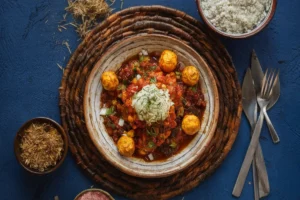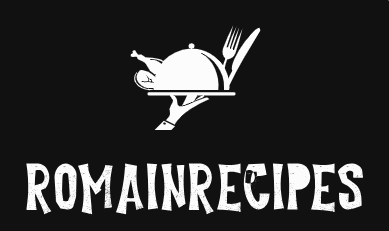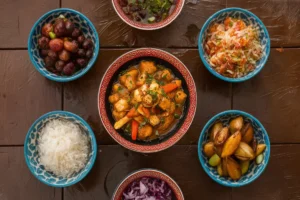Moroccan cuisine is a tantalizing mosaic of flavors, colors, and aromas, rooted in the country’s rich history and diverse cultural influences. From the bustling souks of Marrakesh to the serene landscapes of the Atlas Mountains, Moroccan food is a reflection of the country’s vibrant culture and love for communal eating. In this article, we’ll explore the key elements that define Moroccan cuisine, popular dishes you must try, and how to bring the essence of Morocco into your own kitchen.
1. The Core of Moroccan Cuisine: Ingredients and Spices
At the heart of Moroccan cooking is a robust use of spices and fresh ingredients. These elements come together to create dishes that are rich in flavor and aroma.
Key Spices in Moroccan Cooking
- Cumin: Adds an earthy warmth, essential in tagines and couscous.
- Coriander: Offers a citrusy touch that complements both meats and vegetables.
- Saffron: The world’s most expensive spice, providing a luxurious golden color and subtle sweetness to dishes like Paella.
- Cinnamon: Used in savory and sweet dishes, providing a unique depth of flavor.
- Paprika: Adds a mild, sweet heat to many Moroccan dishes.
These spices are often combined with fresh herbs such as cilantro and parsley, which enhance the freshness of the dishes. Together, they form the foundation of Moroccan culinary magic.
To learn more about the spices used in Moroccan cuisine and how they are grown, check out this detailed guide on Moroccan spices.
Essential Ingredients in Moroccan Dishes
- Olive Oil: A staple in Moroccan cooking, used in everything from marinades to frying.
- Preserved Lemons: Lemons preserved in salt and their own juices, providing a unique tangy flavor to many dishes.
- Couscous: A versatile grain that forms the base of many meals, often steamed to fluffy perfection.
- Almonds and Honey: Commonly used in desserts, adding a sweet, nutty flavor.
2. Signature Moroccan Dishes You Must Try
2.1. Tagine: The Iconic Moroccan Dish
Tagine, a slow-cooked stew named after the clay pot in which it is traditionally cooked, is one of the most iconic dishes of Moroccan cuisine. Whether made with lamb, chicken, or vegetables, the dish is characterized by its tender meat and rich, fragrant sauce.
Ingredients for a Traditional Lamb Tagine
- 1 kg of lamb, cut into chunks
- 2 onions, chopped
- 3 cloves of garlic, minced
- 1 tsp ground cumin
- 1 tsp ground coriander
- 1 tsp cinnamon
- A pinch of saffron threads
- 1 cup of dried apricots
- 2 tbsp honey
- 1 tbsp olive oil
- Salt and pepper to taste
Cooking Instructions
- Heat the olive oil in a tagine pot or heavy-bottomed saucepan.
- Sauté the onions and garlic until golden.
- Add the lamb and brown on all sides.
- Stir in the spices, honey, and apricots, ensuring the lamb is well-coated.
- Add enough water to cover the lamb, bring to a boil, then reduce the heat.
- Cover and simmer for 2-3 hours until the meat is tender.
2.2. Couscous: Morocco’s Staple Grain

Couscous is much more than just a side dish; it’s a central part of Moroccan cuisine. Typically served with vegetables and meats, couscous can be a complete meal on its own.
Traditional Moroccan Couscous Recipe
- 2 cups of couscous
- 3 cups of water or broth
- 1 tbsp olive oil
- A variety of vegetables (e.g., carrots, zucchini, chickpeas)
- Spices: cumin, paprika, turmeric
- Salt and pepper to taste
Cooking Instructions
- In a large pot, bring the water or broth to a boil.
- Add the couscous and olive oil, stir, then cover and remove from heat.
- Let the couscous steam for about 5 minutes, then fluff with a fork.
- Sauté the vegetables with the spices until tender.
- Serve the couscous with the vegetables on top, drizzling with any remaining broth.
For more on how to master the art of cooking couscous, visit our complete couscous guide.
2.3. Harira: The Soulful Moroccan Soup
Harira is a traditional Moroccan soup made with tomatoes, lentils, chickpeas, and a blend of spices. It is particularly popular during Ramadan, serving as the first course to break the fast.
Simple Harira Recipe
- 1 cup of lentils
- 1 cup of chickpeas, soaked overnight
- 200g of lamb or beef, cut into small pieces
- 4 tomatoes, pureed
- 1 onion, finely chopped
- 2 tsp ground ginger
- 1 tsp cinnamon
- 1 tsp turmeric
- 1 bunch of cilantro, chopped
- 1 bunch of parsley, chopped
- Salt and pepper to taste
Cooking Instructions
- Sauté the meat with onions until browned.
- Add the tomatoes, ginger, cinnamon, turmeric, and chickpeas. Cover with water.
- Simmer for about an hour, then add the lentils.
- Stir in cilantro and parsley just before serving.
Table: Traditional Moroccan Dishes Overview
| Dish | Main Ingredients | Cooking Method |
|---|---|---|
| Tagine | Meat, vegetables, dried fruits, spices | Slow-cooked in tagine |
| Couscous | Semolina wheat, vegetables, broth | Steamed |
| Harira | Lentils, chickpeas, lamb/beef, tomatoes, spices | Simmered |
3. Sweet Treats and Desserts: A Taste of Moroccan Hospitality
3.1. Moroccan Mint Tea: The Iconic Beverage
No Moroccan meal is complete without a cup of Moroccan mint tea. This sweet, refreshing beverage is a symbol of Moroccan hospitality and is enjoyed at any time of day.
How to Make Moroccan Mint Tea
- 1 tbsp green tea leaves
- 1 bunch of fresh mint
- 4 cups of boiling water
- 4 tbsp sugar (adjust to taste)
Instructions
- Rinse the green tea leaves with boiling water to remove bitterness.
- Add the tea leaves, fresh mint, and sugar to a teapot.
- Pour the boiling water over the ingredients and steep for 5 minutes.
- Pour the tea into glasses from a height to create froth, and serve hot.
Moroccan mint tea pairs perfectly with sweet treats like Baklava or M’hancha, pastries filled with nuts and honey.
3.2. Moroccan Pastries: Delightful Endings
Moroccan desserts often combine sweetness with a touch of spice. Almonds, honey, and orange blossom water are common ingredients in these delightful treats.
Popular Moroccan Desserts
- Baklava: A sweet pastry made with layers of phyllo dough, filled with chopped nuts and sweetened with honey.
- M’hancha: A coiled pastry filled with almond paste and flavored with orange blossom water.
- Chebakia: Sesame cookies shaped into intricate patterns and soaked in honey.
drinks
Conclusion
Moroccan food is more than just sustenance; it’s a reflection of the country’s rich history, diverse culture, and communal spirit. Each dish tells a story, and each flavor brings a piece of Morocco into your home. Whether you’re preparing a slow-cooked tagine, steaming a pot of couscous, or simply enjoying a cup of mint tea, you are partaking in a culinary tradition that has been passed down through generations.
FAQs About Moroccan Food
Q1: What is the most popular dish in Moroccan cuisine?
A: The most popular dish is undoubtedly tagine, a slow-cooked stew made with meat, vegetables, and a blend of aromatic spices.
Q2: Is Moroccan food spicy?
A: While Moroccan food is flavorful, it is not typically very spicy. The cuisine relies more on aromatic spices like cumin, cinnamon, and saffron rather than hot chilies.
Q3: What is couscous, and how is it served?
A: Couscous is a type of steamed semolina wheat and is often served as a base for dishes with vegetables, meats, and a savory broth.
Q4: Can I make Moroccan dishes without a tagine pot?
A: Yes, a heavy-bottomed saucepan or Dutch oven can be used as a substitute for a traditional tagine pot.
Q5: How do I store preserved lemons?
A: Preserved lemons should be stored in their brine in a cool, dark place. Once opened, they can be kept in the refrigerator for up to a year.


